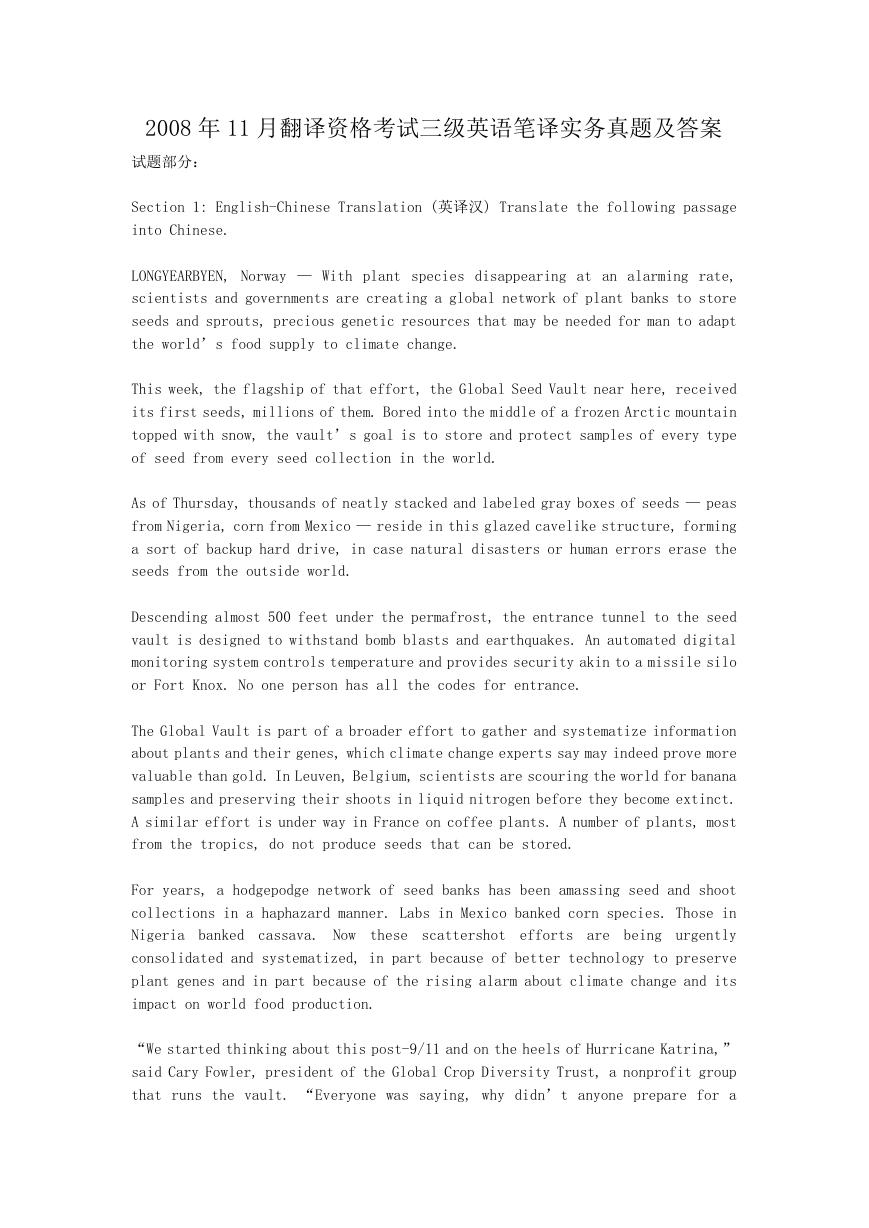2008 年 11 月翻译资格考试三级英语笔译实务真题及答案
试题部分:
Section 1: English-Chinese Translation (英译汉) Translate the following passage
into Chinese.
LONGYEARBYEN, Norway — With plant species disappearing at an alarming rate,
scientists and governments are creating a global network of plant banks to store
seeds and sprouts, precious genetic resources that may be needed for man to adapt
the world’s food supply to climate change.
This week, the flagship of that effort, the Global Seed Vault near here, received
its first seeds, millions of them. Bored into the middle of a frozen Arctic mountain
topped with snow, the vault’s goal is to store and protect samples of every type
of seed from every seed collection in the world.
As of Thursday, thousands of neatly stacked and labeled gray boxes of seeds — peas
from Nigeria, corn from Mexico — reside in this glazed cavelike structure, forming
a sort of backup hard drive, in case natural disasters or human errors erase the
seeds from the outside world.
Descending almost 500 feet under the permafrost, the entrance tunnel to the seed
vault is designed to withstand bomb blasts and earthquakes. An automated digital
monitoring system controls temperature and provides security akin to a missile silo
or Fort Knox. No one person has all the codes for entrance.
The Global Vault is part of a broader effort to gather and systematize information
about plants and their genes, which climate change experts say may indeed prove more
valuable than gold. In Leuven, Belgium, scientists are scouring the world for banana
samples and preserving their shoots in liquid nitrogen before they become extinct.
A similar effort is under way in France on coffee plants. A number of plants, most
from the tropics, do not produce seeds that can be stored.
For years, a hodgepodge network of seed banks has been amassing seed and shoot
collections in a haphazard manner. Labs in Mexico banked corn species. Those in
Nigeria banked cassava. Now these scattershot efforts are being urgently
consolidated and systematized, in part because of better technology to preserve
plant genes and in part because of the rising alarm about climate change and its
impact on world food production.
“We started thinking about this post-9/11 and on the heels of Hurricane Katrina,”
said Cary Fowler, president of the Global Crop Diversity Trust, a nonprofit group
that runs the vault. “Everyone was saying, why didn’t anyone prepare for a
�
hurricane before? We knew it was going to happen.
“Well, we are losing biodiversity every day — it’s a kind of drip, drip, drip.
It’s also inevitable. We need to do something about it.”
This week the urgency of the problem was underscored as wheat prices rose to record
highs and wheat stores dropped to the lowest level in 35 years. A series of droughts
and new diseases cut wheat production in many parts of the world. “The erosion of
plants’ genetic resources is really going fast,” said Dr. Rony Swennen, head of
the division of crop biotechnology at the Catholic University of Leuven in Belgium,
who has preserved half of the world’s 1,200 banana types. “We’re at a critical
moment and if we don’t act fast, we’re going to lose a lot of plants that we may
need.”
The United Nations International Treaty on Plant Genetic Resources, ratified in 2004,
created a formal global network for banking and sharing seeds, as well as for studying
their genetic traits. Last year, its database received thousands of new seeds.
A system of plant banks could be crucial in responding to climate crises since it
could identify genetic material and plant strains better able to cope with a changed
environment.
Here at the Global Vault, hundreds of gray boxes containing seeds from places ranging
from Syria to Mexico were moved this week into a freezing vault to be placed in
suspended animation. They harbor a vast range of qualities, like the ability to
withstand drier, warmer climate.
Section 2: Chinese-English Translation (汉译英) Translate the following passage
into English.
在上海的现代化轻轨列车上,上班族有的在打手机,有的在用笔记本电脑,有的在观赏车内
顺平显示器上播放的电影。全国各地,半导体工厂在昔日的农田拔地而起,而在日益扩展的
城市中,众多大学校园和新公司林立的高科技园区正再现美国硅谷的模式。
中国拥有大量的技术人才。依靠这些人才,中国的高科技设计和开发能力正日益提 高。 中
国承担了大批全球制造业务,生产电视机、电脑、移动电话和其他电子产品。同时,中国正
计划制造电脑芯片和网络交换机等更复杂、更精密的高科技产品。
中国政府正致力于扶持信息技术产业,使之成为一大经济支柱,重点发展半导体和软件工业,
并对新公司采取提供价廉土地和税收优惠等激励措施。
对外国投资者来说,中国的美丽在于其规模庞大、扩展迅速的国内市场。另一个优势则是低
工资,中国工程师的薪水仅是西方同行的十分之一。
�
答案部分:
Section 1: 英译汉
挪威朗伊尔城——随着植物物种正在以骇人听闻的速度灭绝,科学家和各国政府正在创建全
球网络性的植物库来储存种子和苗芽。人类可以利用这些珍贵的种芽资源确保充足的食物供
应,以应对气候变化。
本周,作为这种不懈努力的旗舰机构,“全球种子地库”接收了首批数百万种的种子。该地
库建于北极的一座白雪皑皑的大山之中,其目标是储存和保护世界各地收藏的各类种子样
本。
截至周四,成千上万个堆放整齐且贴有标签的灰色种盒在上釉的洞穴式结构中安家落户,
如尼日利亚的豌豆、墨西哥的玉米。这些盒子就如已经备份了的电脑硬盘,以防世界上的植
物物种会因自然灾害和人为破坏而消失。
通往种子地库的入口隧道,位于永冻带下约 500 英尺处,其设计旨在防御爆炸和地震。自
动化数字监控系统用于控制温度并提供类似导弹发射井或福特诺克斯军事基地的安全保障。
任何人都不单独拥有进入种子库的全部密码。
目前,世界上很多人士致力于收集种子及其种子基因的信息并使之系统化,全球种子地库是
这种全球性努力的的一个缩影。气候变化专家称,这些信息要比金子还要贵重。在比利时的
鲁汶,科学家正在搜集世界上的香蕉样本并将香蕉芽保存在液体氮中,以防其灭绝。法国也
正在进行类似的努力,保护咖啡物种。很多植物,大多数是来自热带地区的植物,无法通过
种子繁殖,不能产生可供储存的种子。
多年来,很多庞杂的种子库网络一直以随意的方式收集种子和苗芽。例如,墨西哥的实验室
收藏玉米种,尼日利亚的实验室收藏木薯种。现在,正对这些分散的努力进行亟需的整合和
系统化操作。之所以可以这样做,部分原因是储存植物基因技术的更新,部分原因是气候变
化的警钟继续长鸣及其对世界粮食产量的影响。
卡里•福勒是一家负责管理种子库的非营利性组织全球作物多样性托管会的总裁,他说:
“我们是在‘9•11’事件之后、尤其是卡特里娜飓风之后,开始有这个构想的。”他还说:
“每个人都在问:为什么事先不作好迎接飓风的准备呢?我们明明知道会发生飓风的。”
他指出:“喏,我们每天都在损失生物多样性——一点一滴地在损失。这种损失没有止步的
迹象,我们必须为此做点什么。”
本周,由于小麦价格上升到最高纪录水平和小麦储存量下滑到 35 年来最低水平,更加突出
了这个问题的紧迫性。由于一连串的干旱及新的疾病,世界很多地方的小麦产量下降。罗尼
•斯文奈恩博士现任比利时鲁汶天主教大学作物生物技术部主任,他保存了世界上
�
1200 种香蕉种的一半以上。斯文奈恩博士说:“植物基因资源正在受到快速侵蚀。”他还指
出:“我们正处于关键时刻,如果不迅速采取行动,我们将失去很多我们需要的植物物种。”
已于 2004 年获得批准的联合国国际植物基因资源条约创建了一个正式的全球网络,旨在对
种子进行储存和共享并对其遗传特征进行研究。去年,有成千上万的新种子在其数据库安家
落户。
由于植物库系统能够识别出那些对环境变化适应能力较强的基因物质和植物种类,因而这种
系统能在应对气候危机中发挥至关重要的作用。
本周,数以百计的装有种子的灰色盒子从叙利亚、墨西哥等地运至全球种子地库,藏于这个
冷冻库之中。储存在这里的种子具有很多特性,如能够抵御较为干燥和较为温暖的气候。
Section 2: 汉译英参考译文
Commuters sitting on Shanghai’s modern light-rail trains talk on mobile phones tap
away on laptops or watch films on the train’s flat-screen monitors. Around the
country new semiconductor factories are shooting up on former farmland while
universities and high-tech zones packed with start-up companies are reproducing the
Silicon Valley model in its sprawling cities.
China has plenty of technical brainpower. This talent is enhancing its high-tech
design and development capabilities.
It has taken over a large amount of global manufacturing turning out television sets
computers mobile phones and other electronic products. At the same time it plans
to produce more sophisticated high-tech products such as computer chips and network
switches.
The Chinese government is on a mission to make information technology a pillar of
the economy targeting semiconductor and software industries and introducing
incentives like cheap land and tax breaks for new companies.
China’s appeal for foreign investors comes from its huge and rapidly-expanding
domestic market. Another advantage is low wages. Salaries of Chinese engineers can
be as low as one-tenth of those in Western countries.
�








 2023年江西萍乡中考道德与法治真题及答案.doc
2023年江西萍乡中考道德与法治真题及答案.doc 2012年重庆南川中考生物真题及答案.doc
2012年重庆南川中考生物真题及答案.doc 2013年江西师范大学地理学综合及文艺理论基础考研真题.doc
2013年江西师范大学地理学综合及文艺理论基础考研真题.doc 2020年四川甘孜小升初语文真题及答案I卷.doc
2020年四川甘孜小升初语文真题及答案I卷.doc 2020年注册岩土工程师专业基础考试真题及答案.doc
2020年注册岩土工程师专业基础考试真题及答案.doc 2023-2024学年福建省厦门市九年级上学期数学月考试题及答案.doc
2023-2024学年福建省厦门市九年级上学期数学月考试题及答案.doc 2021-2022学年辽宁省沈阳市大东区九年级上学期语文期末试题及答案.doc
2021-2022学年辽宁省沈阳市大东区九年级上学期语文期末试题及答案.doc 2022-2023学年北京东城区初三第一学期物理期末试卷及答案.doc
2022-2023学年北京东城区初三第一学期物理期末试卷及答案.doc 2018上半年江西教师资格初中地理学科知识与教学能力真题及答案.doc
2018上半年江西教师资格初中地理学科知识与教学能力真题及答案.doc 2012年河北国家公务员申论考试真题及答案-省级.doc
2012年河北国家公务员申论考试真题及答案-省级.doc 2020-2021学年江苏省扬州市江都区邵樊片九年级上学期数学第一次质量检测试题及答案.doc
2020-2021学年江苏省扬州市江都区邵樊片九年级上学期数学第一次质量检测试题及答案.doc 2022下半年黑龙江教师资格证中学综合素质真题及答案.doc
2022下半年黑龙江教师资格证中学综合素质真题及答案.doc